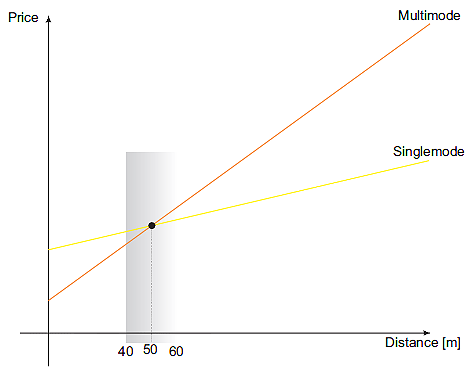In
recent years, due to the wide use of fiber optic technology for data
transmission, the market has experienced large declines in prices of
optical cables and devices, so they have become accessible to many
users. They often consider which kind of the cables and equipment will
be optimal for their applications, multimode or single-mode?
The
best solution is to compare the total prices of the materials and
devices for a particular application. Let's think of a 100 Mbps
fiber-optic link. This task can be carried out with the use of a pair of
media converters. In the case of using multimode fibers, it can be L10021, with range up to 2 km (requires two fibers). Similar pair of media converters for a link with two single-mode fibers is L11041.

Chart showing comparison of costs of fiber optic links based on multimode and single-mode fibers,
taking into account the prices of the mentioned active devices
taking into account the prices of the mentioned active devices
The
pair of media converters for multimode cables costs ca. 20% less than
that of the single-mode equivalent. However, due to lower prices of
single-mode cables, the difference in total costs is compensated even in
the case of comparatively short links (50 meters). The comparison is
based on the prices of universal cables with 4 fibers, L7644 and L7354.
The
conclusion is that installations based on multimode fibers are cheaper
only in the case of very short links, but generally the difference is no
so large. Due to larger potential of single-mode fibers, the choice of
single-mode solutions is more prospective. Multimode fibers should only
be used for very short links, in server rooms etc. Single-mode fibers
are basically the only reasonable solution for data transmission over
greater distances.
No comments:
Post a Comment